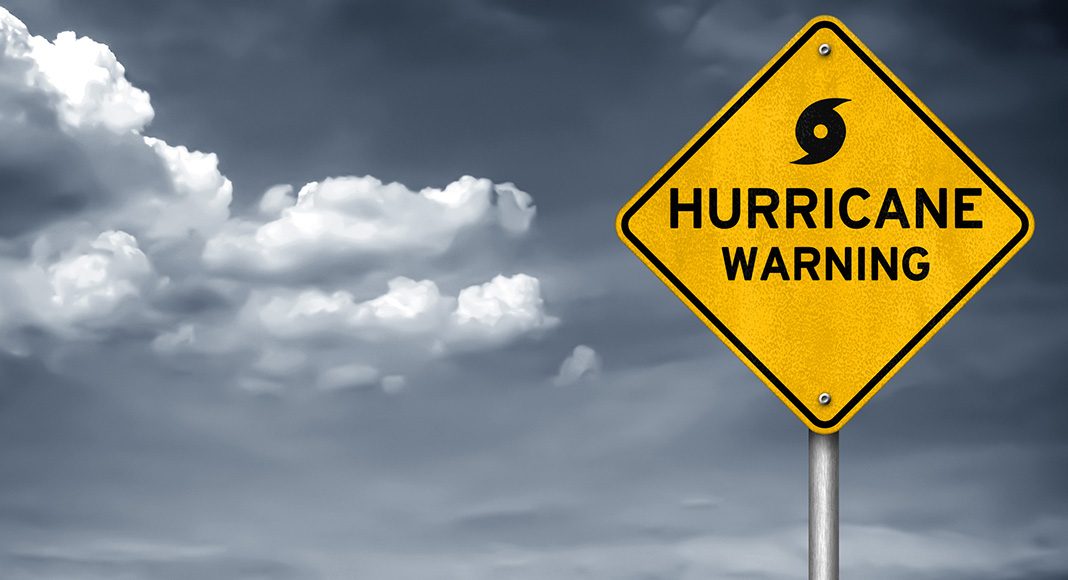The Carolinas and surrounding states are warned to prepare for the worst as Hurricane Florence approaches later this week.
Set to be the first Category 4 hurricane to hit the Carolinas in more than 60 years, Hurricane Florence is currently moving toward the west-northwest near 17 mph (28 km/h), with an increase in speed expected during the next couple of days.
A Storm Surge Watch, meaning possibility of life-threatening inundation from rising water moving inland, is currently in effect for:
- Edisto Beach South Carolina to the North Carolina-Virginia border
- Albemarle and Pamlico Sounds, including the Neuse and Pamlico Rivers
A Hurricane Watch, meaning hurricane conditions are possible within the watch area, is in effect for:
- Edisto Beach South Carolina to the North Carolina-Virginia border
- Albemarle and Pamlico Sounds
The National Hurricane Center states: âMaximum sustained winds are near 130 mph (215 km/h) with higher gusts. Florence is a category 4 hurricane on the Saffir-Simpson Hurricane Wind Scale. Florence is expected to begin re-strengthening later today and continue a slow strengthening trend for the next day or so. While some weakening is expected on Thursday, Florence is expected to be an extremely dangerous major hurricane through landfall.â
Surrounding states should prepare as well
While they may not experience hurricane winds, rainfall in surrounding states could lead to just as dangerous situations if not approached in a safe way.
Check local news and disaster awareness for tips to secure your home and belongings and avoid driving if possible.
If you must drive, carry out the following vehicle checks:
- Be sure your vehicle has been maintained/serviced and is operating safely
- Tires â good tread depth and inflated correctly (including the spare)
- Windshield wipers and washers â working properly. In colder temperatures, use high strength screen-wash
- Lights â clean and working
- Vehicle windows and mirrors â clean, damage-free
Before driving:
- Check local and national TV and Radio for travel and weather information
- Check that you have a full tank of fuel
- Let someone know your destination and your expected time of arrival
- Make sure your cell phone is fully charged but remember you could break down in a “dead area”
- Carry an emergency kit including warm high visibility clothing, hot drinks, food, boots, a flashlight and shovel
Trip planning:
- Use the main roads as much as possible
- Allow extra time for your journey
If you get into trouble while driving:
- Stay with your vehicle if possible, until help arrives.
- If you do have to leave your vehicle, make yourself visible to others
- If you have to abandon your vehicle, give local police the details and park safely to avoid obstruction to maintenance and emergency vehicles
TIPS FORÂ HURRICANE-RELATED WEATHER CONDITIONS:
Driving in flood conditions:
Avoid driving through standing water if you can; it can be deeper than you realize. One foot of water will float many vehicles, and two feet of moving water can carry away most vehicles. Keep in mind that you canât see the conditions beneath flood water, there could be pot holes or debris below water.
If you have no reasonable alternative but to pass through standing water:
- Try to estimate the depth if possible â are other vehicles able to pass through it?
- Look out for downed electrical lines in the water before you enter â donât pass through if you can see power lines
- Drive slowly and steadily
- Drive in the middle of the road if possible where the water will be at its shallowest
- Wait your turn â donât attempt to pass through a flood at the same time as another vehicle
- Test your brakes as soon as you can after passing through water
- Keep in mind that flood water can result in traffic signals not working. In this case, treat an intersection as a four-way stop
Driving during hurricane watch:
Avoid driving completely if you can. If itâs unavoidable:
- Increase your following distance from other vehicles
- Drive at a speed that is appropriate for the conditions
- Keep listening to traffic updates and find shelter in plenty of time if a hurricane is expected to hit
- Be prepared to evacuate from your location
- Flooding can happen without warning before and after a hurricane (see section above)
- Look out for downed utility lines, trees and debris on the road
Driving during thunderstorms:
- It is safest to stay in your car when lightning is present. If you have to park, do so in an open area away from trees
- Watch for flooded roadways
- If you are driving after a thunderstorm, look for downed branches and power lines or other debris lying in the road â drive at a speed that enables you to take avoidance action if needed
- Leave a safe following distance from other vehicles which may stop suddenly to avoid debris in the road
- Hail associated with thunderstorms can hamper visibility and may shatter windshields
Final tips:
- Watch out for vulnerable road users who may be hard to spot in bad weather conditions â and who may be struggling with the conditions
- Beware of âhydroplaningâ when roads are wet. This is caused when a layer of water builds up on the road surface and prevents the vehicle from responding to actions such as steering and braking
- Remember, your safety is the priority. If itâs not safe, donât drive!
Check the latest status of the National Hurricane Centerâs safety alerts for Hurricane Florence



















